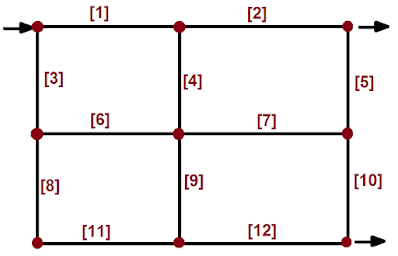The main idea behind the Hardy-Cross method is to force a head loss $h_L$ balance among all pipes that are part of a flow loop. Without the $h_L$ balance flow rates, which are usually the unknown, they cannot be determined. There are other methods, but this is the most familiar.
This methodology, as you may already know, is based on the general equation for mechanical energy balance, so that every loop in the above network must be decomposed into smaller parts, which are in fact the pipe sections.
Note: A loop is a circuit of flow. In other words, a loop is formed by interconnected pipe sections through which the fluid may travel in a given direction. For example, pipe sections [1], [4], [6], and [3] form a loop.
Then, for any of the 12 pipe sections in the network above, a particular head loss is defined as follows,
$h_L^{(n)}=f_F^{(n)}\frac{L_n}{D_n}\frac{v_n^2}{2g}$ Eq. (1)
or as,
$h_L^{(n)}=f_F^{(n)}\frac{L_n}{D_n}\frac{8Q_n^2}{\pi^2 D_n^4 g}$ Eq. (2)
where $n$ indicates any of the pipe sections in a loop ([1], [4], [6], or [3], for example). Also, $n$ was written in parentheses $(n)$ to avoid confusion with powers. Several textbook authors like to write Eq. (2) as,
$h_L^{(n)}=K_nQ_n^2$ Eq. (3)
where $K$ is defined as,
$K_n=f_F^{(n)}\frac{L_n}{D_n}\frac{8}{\pi^2 D_n^4 g}$ Eq. (4)
Following the Hardy-Cross technique, a head loss balance that forms a loop is created. In a very general form, this would look like,
$\sum_{n=1}^{n=m}h_L^{(n)}=0$ Eq. (5)
where $m$ is the total number of pipes forming the loop. For example, for each loop in the network above, $m=4$.
Now, since the $h_L$ balance is not zero per se, you can force it to be zero by making minor adjustments to the flow rates. Substitution of Eq. (3) into Eq. (5) gives,
$\sum_{n=1}^{n=m}K_n Q_n^2=0$ Eq. (6)
and if you add a minor flow rate correction $\Delta Q$ to each pipe section, Eq. (6) becomes,
$\sum_{n=1}^{n=m} K_n \left( Q_n+\Delta Q \right)^2=0$ Eq. (7)
Expansion of Eq. (7) produces,
$\sum_{n=1}^{n=m} K_n \left[ Q_n^2+2Q_n\Delta Q+\left( \Delta Q \right)^2 \right] =0$ Eq. (8)
Since the flow corrections $\Delta Q$ are minor (smaller than 1), then powers of it can be neglected. Thus, Eq. (8) can be reduced to,
$\sum_{n=1}^{n=m} K_n \left[ Q_n^2 + 2Q_n \Delta Q \right] =0$ Eq. (9)
and since $\Delta Q$ is not particular to any pipe section (does not depend on $n$), a further simplification is possible,
$\sum_{n=1}^{n=m} K_n Q_n^2 + 2\Delta Q \sum_{n=1}^{n=m} K_n Q_n=0$ Eq. (10)
Next, the flow rate correction $\Delta Q$ can be easily isolated from Eq. (10) to be,
$\Delta Q =- \frac{\sum_{n=1}^{n=m} K_n Q_n^2 }{2\sum_{n=1}^{n=m} K_n Q_n}$ Eq. (11)
Equation (11) can also be written in terms of $h_L$ to ease calculations,$\Delta Q = - \frac{\sum_{n=1}^{n=m} h_L^{(n)}}{2\sum_{n=1}^{n=m} h_L^{(n)}/Q_n}$ Eq. (12)
Finally, the correction $\Delta Q$ given in Eq. (12) must be applied iteratively to each loop so that with each iteration $\Delta Q$ decreases, assuring that the $h_L$ balance is approaching zero.
At this point, the mass balance has not been mentioned, but this is a weakness of the method.
Any questions? Write in the comments, and I shall try to help.
=========
Ildebrando.



No comments:
Post a Comment